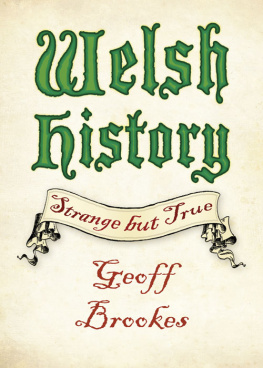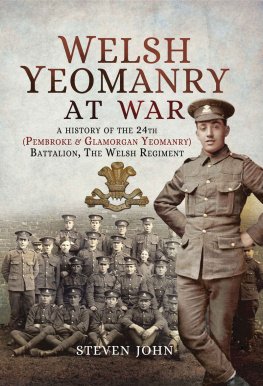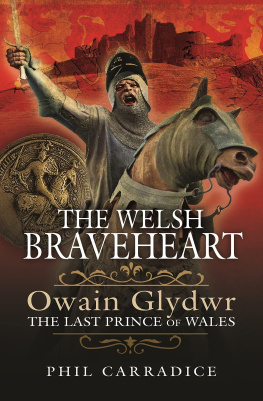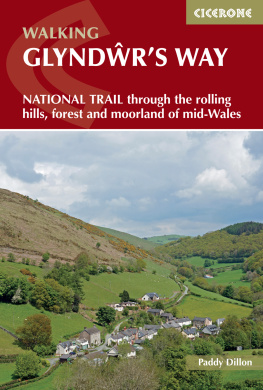Gideon Brough holds a PhD from Cardiff University where, for the past decade, he has taught European History, notably on conflict and diplomacy. His main academic interests are warfare, diplomacy, power relations, geopolitics, insurgencies and identity in western Europe, particularly in France and the nations of the British Isles.
Wales has too often been relegated to the sidelines of history; this book places the events of Glyn Drs revolt into the centre of the history of Europe in the early fifteenth century.
Helen Nicholson, Professor of Medieval History, Cardiff University
In this stimulating, revisionist study of a remarkable soldier and statesman, Gideon Brough explores how and why Owain Glyn Dr was able to secure French support for his struggle against England, thereby ensuring that the Welsh rebellion became a distinctive thread within the tangled skein of the Hundred Years War. From the bloody battle on the slopes of Bryn Glas to the stand-off near Worcester between the Franco-Welsh army and Henry IVs host, the military aspects of the story are compelling. But it is in his exploration of the protagonists diplomatic manoeuvres, perhaps most notably those of the English envoys who broke the Franco-Welsh alliance, that Broughs book particularly impresses.
Dr Andrew Ayton, Honorary Senior Research Fellow at the University of Hull and the University of Keele
Soldiers killing villagers or townsfolk.
The Rise and Fall of Owain Glyn Dr
England, France and the Welsh Rebellion in the
Late Middle Ages
Gideon Brough
Published in 2017 by
I.B.Tauris & Co. Ltd
London New York
www.ibtauris.com
Copyright 2017 Gideon Brough
The right of Gideon Brough to be identified as the author of this work has been asserted by the author in accordance with the Copyright, Designs and Patents Act 1988.
All rights reserved. Except for brief quotations in a review, this book, or any part thereof, may not be reproduced, stored in or introduced into a retrieval system, or transmitted, in any form or by any means, electronic, mechanical, photocopying, recording or otherwise, without the prior written permission of the publisher.
Every attempt has been made to gain permission for the use of the images in this book. Any omissions will be rectified in future editions.
References to websites were correct at the time of writing.
The cover design is an interpretation of the image viewed on one side of Owains Great Seal. The current debates on the lions posture and colours are acknowledged here. However, it is reasonable to assert that their posture was rampant rather than salient. Also, there has been some discussion whether their colours were red and gold, or if the black lion of Powys Fadog had also been blended into the design. Bearing these points in mind, the cover image seems a reasonable representation of his probable colours.
ISBN: 978 1 78453 593 3
eISBN: 978 1 78672 110 5
ePDF: 978 1 78673 110 4
A full CIP record for this book is available from the British Library
A full CIP record is available from the Library of Congress
Library of Congress Catalog Card Number: available
Typeset by Fakenham Prepress Solutions, Fakenham, Norfolk NR21 8NN
For Mary, my passionate, fiery, enthusiastic mother,
and
Fred, my kind, loving, impressive father,
Halen Daear Cymru .
A FrenchScots force in action. This stylised scene shows the heavy armour types appropriate for the time of the rebellion in Wales. Imagining WelshFrench flags displayed in this scene affords a vision of how the storming of Carmarthen in 1405 might have been presented.
Contents
Lightly armoured troops looting a village. Late fourteenth century. From Royal Ms 20 C VII in the British Museum.
List of Illustrations
Figure 1 Soldiers killing villagers or townsfolk. This image portrays soldiers during the Jacquerie in France; however, it likely resembles the fate of unknown numbers of English and Welsh villagers during the conflict. (Public domain.)
A FrenchScots force in action. (Public domain.)
Lightly armoured troops looting a village. Late fourteenth century. From Royal Ms 20 C VII in the British Museum. (Public domain.)
Map of Wales showing places and regions which frequently featured during the course of the revolt. The outlined areas show the regions affected by the campaigns of 1400, 1403 and 1405.
The alleged route of the campaign of September 1400.
The main elements, actions and places involved in the 1403 campaign against Carmarthen.
The route of the 1405 expedition to Wales according to the Chronicle of Saint-Denys.
The route of the 1405 expedition to Wales according to Enguerrand de Monstrelet.
Owains commission to Gruffydd Yonge and John Hanmer, 10 May 1404. J392. 27. Source: T. Matthews, ed., Welsh Records in Paris (Carmarthen: Spurrell, 1910), 23.
.
Territorial interests in north-eastern France, circa 1407. Sources: (Left) R. Vaughan, Valois Burgundy (London: Allen Lane, 1975), viii; (Right) B. Schnerb, Les Armagnacs et Les Bourguignons , La Maudite Guerre (Paris: Perrin, 2009), 18 (authors translation and adaptation of the original French).
Tax units affected by the rebellion. Source: H. Watt, On Account of the Frequent Attacks and Invasions of the Welsh, in G. Dodd and D. Biggs, The Reign of Henry IV: Rebellion and Survival, 14031413 (York: York University Press, 2008), 57.
Acknowledgements
T here is never sufficient space to adequately thank everyone involved in matters such as research, publications and life in general. So, in whittling this part of the process down to the barest minimum, I first wish to thank Peter Coss and Peter Edbury for their consistently positive feedback throughout my doctoral research. In addition, I owe Peter Edbury my deep personal and professional gratitude for his advice and support when I particularly needed it. With regard to this project, it was he who encouraged me to critically examine the foundations on which our received wisdom stands. The new vision of the beginning and the end of the revolt proposed here, among other elements, is largely the result of the application of this close scrutiny. I also express my appreciation to Andrew Ayton and Helen Nicholson for their valuable advice in numerous matters, as well as for one of the most enjoyable conversations of my life: my viva.
I am also grateful to Cardiff University for the scholarship I was awarded which enabled me to follow my doctoral studies there and notably to Professor Chris Williams and Professor Justin Lewis for their support in accessing Cardiff University funding assisting scholarly publications in the fields of Welsh culture, history and literature. In addition, I am thankful that the publishers, I.B.Tauris, have provided me this opportunity to disavow a work from 2002. Although polemics can serve a purpose by offering a mirror to the excesses of other, accepted perspectives, I am pleased to disassociate myself with that problematic publication for numerous reasons; this work erases and replaces it. I am grateful to Lester Crook, Joanna Godfrey, Sara Magness and others at I.B.Tauris who helped bring this project to fruition.












